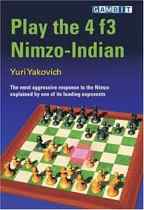Play the 4.f3 Nimzo-Indian
Yuri Yakovich

I was very excited when this book arrived. The line 1.d4 Nf6 2.c4 e6 3.Nc3 Bb4 4.f3 was an important part of my repertoire for several years. I cooked up many new ideas and came to appreciate Whites many dynamic possibilities, the systems many subtle points, and the fact that few players were ready to face it!
I have to admit feeling somewhat annoyed when I read the following about the sharp position that occurs after 1.d4 Nf6 2.c4 e6 3.Nc3 Bb4 4.f3 c5 5.d5 Bxc3+ 6.bxc3 Nh5 7.g3 f5 8.e4 f4: “Up to the end of the 1980s it was generally thought that 7. f4 promised Black a good game. However, Moskalenkos discovery of 8.dxe6! gives White the advantage.
Yakovich then gives quite a bit of analysis, including: 9.dxe6 Qf6 10.Ne2 fxg3 11.Bg2 Qe6 12.hxg3 Nf6 13.g4 0-0 14.g5 Ne8 15.Nf4 Qe5 16.Nd5 (Which he correctly assesses as winning for White).
The problem with the comments above is that I discovered AND played 9.dxe6 (sometimes its 8.dxe6, depending on whether or not Black has rushed to play Bxc3+) back in 1982. Even more irksome was his analysis up to 16.Nd5, which occurred in my game vs. G Kane at the Bagby Memorial (San Francisco) 1982. The finish (rather poorly handled by me) was: 16 …Qg3+ 17.Kf1 Nc6 18.Rh3 Qe5 19.Kg1 g6 20.f4 Qg7 21.e5 d6 22.Nf6+ Nxf6 23.exf6 Qf7 24.Re3! Qc7 25.Bd5+ Kh8 26.Qe2 Bf5 27.Bd2 Rad8 28.Rae1 h5 29.Re7! Rd7 30.Re8 Rd8 31.Rxf8+ Rxf8 32.Qe8! Qd8 33.Bxc6 bxc6 34.Qxc6 Qd7 35.Qxd7 Bxd7 36.Re7 Bf5 37.Rxa7 Rb8 38.Ra6 Kg8 39.Rxd6 Ra8 40.Be3, 1-0.
This game (with analysis) eventually appeared in The Players Chess News. So “Moskalenkos discovery wasnt his discovery at all. I bring this up to vent, but also to show the reader just how interesting many lines from 4.f3 can be.
However, the 4.f3 system isnt all tactics and attack. One must also learn to handle small advantages and the two Bishops, as frequently comes to pass after 1.d4 Nf6 2.c4 e6 3.Nc3 Bb4 4.f3 d5 5.a3 Bxc3+ 6.bxc3 c5 7.cxd5 Nxd5 8.dxc5. Another game from 1982 was Silman – MacFarland: 8… f5 9.c4 (Now its known that moves like 9.Qc2 and 9.Ng3 give White a better chance to obtain an opening advantage.) 9… Qf6 10.Bd2 (This offers nothing, though the superior 10.Bg5 also grants Black equality with careful play.) 10 …Nc7? (10 …Nc3 11.Qc1 Na4 is better) 11.Nh3 Nc6 12.Rc1 0-0 13.Bc3 Qe7 14.Qd6 Na6 15.Qxe7 Nxe7 16.Be5 Bd7 17.Rb1 Bc6 18.Nf2 Rfe8 19.Nd3 Rad8 20.e3 Ng6 21.Bd6 Nb8 22.Be2 Nd7 23.Kf2 Rc8 24.Rhc1 Red8 25.Rb2 Nf6 26.Nf4 Kf7 27.Nxg6 Kxg6 28.h3 Kf7 29.g4 h6 30.Rg1 Ne8 31.Be5 Black is suffering, and White won a long, hard game.
Yakovich, who plays this system himself with great success, does an impressive job in giving all the analysis you will need, and also in sharing new moves and general plans with the reader as well. He mixes prose with variations nicely, and this makes the book a joy to read.
Though I was tossing 4.f3 out in 1982, the system seems as fresh and effective now as it did then (in fact, it seems even more effective then it did back in my day). If you are looking for a way to challenge the Nimzo-Indian for White, then I highly recommend 4.f3. And if you play the Nimzo-Indian for Black and wish to be properly prepared for the hordes of players who will soon embrace this system, then Yakovichs book is a must buy.
